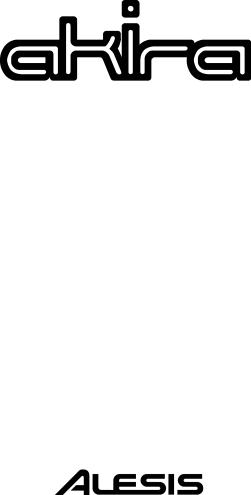Alesis AKIRA User Manual

Reference Manual
This page intentionally left blank
10% |
20% |
30% |
40% |
50% |
60% |
70% |
80% |
90% |
100% |
|||||||||
|
|
|
|
|
|
|
|
|
|
|
|
|
|
|
|
|
|
|

Table Of Contents
Introduction ...................................................... |
3 |
|
Important Safety Instructions....................... |
7 |
|
Chapter One: Quick Start Guide................... |
15 |
|
If |
you can’t wait to get started …...............................................................15 |
|
Step 1: Hook it up to a mixer ...................................................................... |
15 |
|
Step 2: Try some effects ............................................................................... |
16 |
|
Chapter Two: Connections ............................. |
17 |
|
Connecting to an Instrument or Microphone.......................................... |
18 |
|
Connecting to the Effects Send and Return of a Mixing |
|
|
Console ............................................................................................................ |
18 |
|
Connecting to the Channel Inserts of a Mixing Console ...................... |
19 |
|
Connecting to the Main Inserts of a Mixing Console............................ |
20 |
|
Connecting to the Inserts of an Instrument Amplifier ......................... |
20 |
|
About Audio Cables ...................................................................................... |
21 |
|
Bypass Footswitch.............................................................. |
22 |
|
MIDI In and Out.................................................................. |
22 |
|
Chapter Three: Editing ................................... |
23 |
|
Editing Programs ............................................................... |
23 |
|
Storing Your Edits.............................................................. |
24 |
|
Chapter Four: Description of |
|
|
Programs............................................................ |
25 |
|
Reverb Effects 0 - 11........................................................... |
25 |
|
0 |
HALL........................................................................................................... |
25 |
1 |
VOCAL HALL.......................................................................................... |
26 |
2 |
VOCAL PLATE........................................................................................ |
26 |
3 |
DRUM ROOM.......................................................................................... |
26 |
4 |
SPACE ......................................................................................................... |
26 |
5 |
TRASH CAN ............................................................................................. |
27 |
6 |
GATED....................................................................................................... |
27 |
7 |
REVERSE .................................................................................................. |
27 |
8 |
DYNAMIC REVERB.............................................................................. |
27 |
9 |
FLANGED REVERB............................................................................ |
28 |
10 PITCHED REVERB............................................................................. |
28 |
|
11 G GARAGE ............................................................................................ |
28 |
|
Delay Effects 12 - 18 ........................................................... |
29 |
|
12 DELAY ..................................................................................................... |
29 |
|
13 STEREO DELAY .................................................................................. |
29 |
|
14 RUNAWAY .............................................................................................. |
30 |
|
15 LPF DELAY ............................................................................................ |
30 |
|
16 HPF DELAY ........................................................................................... |
30 |
|
17 BPF DELAY............................................................................................ |
30 |
|
18 PHASOR DELAY.................................................................................. |
31 |
|
1

Table Of Contents |
|
|
Pitch Effects 19 - 29 ........................................................... |
31 |
|
19 PHASOR 1............................................................................................... |
31 |
|
20 PHASOR 2............................................................................................... |
31 |
|
21 |
AUTOPHAZ ........................................................................................... |
32 |
22 |
FLANGER............................................................................................... |
32 |
23 |
INV FLANGER ..................................................................................... |
32 |
24 |
DUAL TRANSPOSER.......................................................................... |
32 |
25 |
STEREO DETUNE.............................................................................. |
33 |
26 |
FREQUENCY SHIFT .......................................................................... |
33 |
27 |
CHORUS.................................................................................................. |
33 |
28 VIBRATO ................................................................................................. |
33 |
|
29 VIBRO-WOBBLE................................................................................... |
33 |
|
Filter Effects 30 - 38 ........................................................... |
34 |
|
30 |
BAND LIMIT ......................................................................................... |
34 |
31 |
LP BP HP............................................................................................... |
34 |
32 |
LFO LP.................................................................................................... |
34 |
33 |
AUTOWAH ............................................................................................. |
35 |
34 |
FORMANTS ........................................................................................... |
35 |
35 |
SAMPLED BPF...................................................................................... |
35 |
36 |
RESONATOR......................................................................................... |
35 |
37 |
VOCO-BEND......................................................................................... |
36 |
38 |
VOCODER.............................................................................................. |
36 |
Distortion Effects 39 - 43................................................... |
36 |
|
39 |
RECORD NOISE.................................................................................. |
36 |
40 |
TAPE SATURATOR............................................................................. |
36 |
41 |
FUZZ ........................................................................................................ |
36 |
42 |
DECIMATOR......................................................................................... |
37 |
43 |
GRINDER ............................................................................................... |
37 |
Miscellaneous Effects 44 - 49............................................ |
37 |
|
44 |
RING MODULATOR.......................................................................... |
37 |
45 |
RMS LIMITER ....................................................................................... |
37 |
46 |
SUB BASS................................................................................................. |
38 |
47 |
TREMOLO.............................................................................................. |
38 |
48 |
AUTOPAN............................................................................................... |
38 |
49 VOCAL CANCEL .................................................................................. |
38 |
|
Chapter Five: MIDI .......................................... |
39 |
|
MIDI Program Change ................................................................................ |
39 |
|
Setting the MIDI Channel............................................................................ |
39 |
|
“Soft” MIDI Thru......................................................................................... |
39 |
|
Using MIDI Continuous Controllers......................................................... |
40 |
|
Chapter Six: Troubleshooting ....................... |
41 |
|
Specifications.................................................... |
43 |
|
Warranty/Contact Alesis ................................. |
45 |
|
Program Chart.................................................. |
47 |
|
2

Introduction
Welcome!
Thank you for making the Alesis Akira™ a part of your studio. Since 1984, we've been designing and building creative tools for the audio community. We believe in our products, because we've heard the results that creative people like you have achieved with them. One of Alesis' goals is to make high-quality studio equipment available to everyone, and this Reference Manual is an important part of that. After all, there's no point in making equipment with all kinds of capabilities if no one explains how to use them. So, we try to write our manuals as carefully as we build our products.
The goal of this manual is to get you the information you need as quickly as possible, with a minimum of hassle. We hope we've achieved that. If not, please drop us an email and give us your suggestions on how we could improve future editions of this manual.
We hope your investment will bring you many years of creative enjoyment and help you achieve your goals.
Sincerely,
The people of Alesis
For more effective service and product update notices, please register your Akira online at:
http://www.alesis.com/ support/warranty.htm
3

Introduction
About the Akira
Alesis, the company that created affordable effects processing with the introduction of the MidiVerb, now offers the Akira Effects Processor. Following in the grand tradition of the MidiVerb, MicroVerb and NanoVerb products, the Akira comes complete with 100 studio quality 24-bit digital effects in a compact, industry standard 19” rack mount package. The Akira is suitable for use in everything from guitar rigs to professional recording studios.
Akira Key Features
o50 preset studio quality 24-bit effects including:
§12 Reverbs (halls, rooms and non-linear)
§7 Delays (mono, stereo and filtered
§11 Pitch Effects (phasor, flanger, chorus, vibrato and harmonizer)
§9 Filter Effects (including vocoder)
§5 Distortion Effects
§6 Miscellaneous Effects (including a vocal eliminator and limiter)
o 50 user locations to store your custom edits of the presets.
oThree parameter knobs (X, Y and Z) for quick editing of each program’s most important effect settings.
o MIDI program select.
o MIDI parameter control.
o High-quality 24-bit true stereo signal path.
o Balanced input and output for optimum noise rejection.
oSwitchable level control from +4dBu to – 10dBV for both professional and consumer applications.
oEasy, consistent operation from the front panel with no paging through windows of parameters on cryptic LCDs.
oInternal switching power supply for easy worldwide operation.
4

Introduction
What You Can Do With Your Akira
When you have the Akira properly connected, you can:
oadd space or “room sound” to dry or sterile sounds using the Halls, Rooms and Reverse reverberators.
ogenerate echoes (multiple repeats) with different spectral characteristics to your source with the Delay programs.
ocreate lively ensemble effects from a single instrument or static section using the Chorus and Phasor programs.
ointroduce classic warm, metallic sweeping effects that simulate analog tape fluctuation using the Flange programs.
oreproduce the classic guitar amp Tremolo effect on both instruments and vocals.
oanimate your instruments with an arcane synthesized edge by applying the LFO-driven Filter effects and Ring Modulator.
oshape the tone of your source material with several static Filters in the spirit of vintage and modern modular synthesizers.
omove your polite-sounding instruments and vocals into aggressive territory using the palette of Distortion effects.
oadd punch, warmth and character to your tracks with the compressor – limiter effects.
oremove the vocal and other lead instruments from an existing recording with the Vocal Eliminator program.
5

Introduction
How to Use This Manual
This manual is divided into the following sections describing the various functions and applications for the Akira. While it's a good idea to read through the entire manual once carefully, those having general knowledge about studio equipment should use the table of contents to look up specific functions.
Chapter 1: Quick Start. If you're already experienced with recording, this will get you started using the Akira right away. It's a short guide to the essential elements of hooking it up and using it for the first time. A brief tour of the front and back panels is included.
Chapter 2: Connection give detailed instructions for connecting the Akira to a variety of typical audio systems.
Chapter 3: Editing tells how you can easily edit and store the three most important parameters of each Akira program.
Chapter 4: Description of Programs gives you a detailed explanation of each of the Akira’s 50 effects programs.
Chapter 5: MIDI. This chapter describes the (M)usical (I)nstrument (D)igital (I)nterface functionality of the Akira.
Chapter 6: Troubleshooting. Refer to this chapter if you experience any problems while using the Akira.
Specifications: Detailed technical information about your Akira.
Program Chart: A list of your Akira’s 50 presets with program and parameter descriptions.
6
Helpful tips and advice are highlighted in a shaded box like this
When something important appears in the manual, an exclamation mark (like the one shown at left) will appear with some explanatory text. This symbol indicates that this information is vital when operating the Akira.

Important Safety
Instructions
Important Safety Instructions (English)
Safety symbols used in this product
 This symbol alerts the user that there are important operating and maintenance instructions in the literature accompanying this unit.
This symbol alerts the user that there are important operating and maintenance instructions in the literature accompanying this unit.
 This symbol warns the user of uninsulated voltage within the unit that can cause dangerous electric shocks.
This symbol warns the user of uninsulated voltage within the unit that can cause dangerous electric shocks.
 This symbol warns the user that output connectors contain voltages that can cause dangerous electrical shock.
This symbol warns the user that output connectors contain voltages that can cause dangerous electrical shock.
Please follow these precautions when using this product:
 1. Read these instructions.
1. Read these instructions.
2.Keep these instructions.
3.Heed all warnings.
4.Follow all instructions.
5.Do not use this apparatus near water.
6.Clean only with a damp cloth. Do not spray any liquid cleaner onto the faceplate, as this may damage the front panel controls or cause a dangerous condition.
7.Install in accordance with the manufacturer's instructions.
8.Do not install near any heat sources such as radiators, heat registers, stoves, or other apparatus (including amplifiers) that produce heat.
9.Do not defeat the safety purpose of the polarized or grounding-type plug. A polarized plug has two blades with one wider than the other. A grounding-type plug has two blades and a third grounding prong. The wide blade or the third prong are provided for your safety. When the provided plug does not fit into your outlet, consult an electrician for replacement of the obsolete outlet.
10.Protect the power cord from being walked on or pinched, particularly at plugs, convenience receptacles, and the point where they exit from the apparatus.
11.Use only attachments or accessories specified by the manufacturer.
Continued next page
7

Important Safety Instructions
12.Use only with a cart, stand, bracket, or table designed for use with professional audio or music equipment. In any installation, make sure that injury or damage will not result from cables pulling on the apparatus and its mounting. If a cart is used, use caution when moving the cart/apparatus combination to avoid injury from tip-over.
13.Unplug this apparatus during lightning storms or when unused for long periods of time.
14.Refer all servicing to qualified service personnel. Servicing is required when the apparatus has been damaged in any way, such as when the power-supply cord or plug is damaged, liquid has been spilled or objects have fallen into the apparatus, the apparatus has been exposed to rain or moisture, does not operate normally, or has been dropped.
15.This unit produces heat when operated normally. Operate in a well-ventilated area with at least six inches of clearance from peripheral equipment.
16.This product, in combination with an amplifier and headphones or speakers, may be capable of producing sound levels that could cause permanent hearing loss. Do not operate for a long period of time at a high volume level or at a level that is uncomfortable. If you experience any hearing loss or ringing in the ears, you should consult an audiologist.
17.Do not expose the apparatus to dripping or splashing. Do not place objects filled with liquids (flower vases, soft drink cans, coffee cups) on the apparatus.
18.WARNING: To reduce the risk of fire or electric shock, do not expose this apparatus to rain or moisture.
8

Important Safety Instructions
Instructions de Sécurité Importantes (French)
Symboles utilisés dans ce produit
 Ce symbole alèrte l’utilisateur qu’il existe des instructions de fonctionnement et de maintenance dans la documentation jointe avec ce produit.
Ce symbole alèrte l’utilisateur qu’il existe des instructions de fonctionnement et de maintenance dans la documentation jointe avec ce produit.
 Ce symbole avertit l’utilisateur de la présence d’une tension non isolée à l’intérieur de l’appareil pouvant engendrer des chocs électriques.
Ce symbole avertit l’utilisateur de la présence d’une tension non isolée à l’intérieur de l’appareil pouvant engendrer des chocs électriques.
 Ce symbole prévient l'utilisateur de la présence de tensions sur les raccordements de sorties, représentant un risque d'électrocution.
Ce symbole prévient l'utilisateur de la présence de tensions sur les raccordements de sorties, représentant un risque d'électrocution.
Veuillez suivre ces précautions lors de l’utilisation de l’appareil:
 1. Lisez ces instructions.
1. Lisez ces instructions.
2.Gardez ces instructions.
3.Tenez compte de tous les avertissements.
4.Suivez toutes les instructions.
5.N’utilisez pas cet allareil à proximité de l’eau.
6.Ne nettoyez qu’avec un chiffon humide. Il est potentiellement dangereux d'utiliser des pulvérisateurs ou nettoyants liquides sur cet appareil.
7.Installez selon les recommandations du constructeur.
8.Ne pas installer à proximilé de sources de chaleur comme radiateurs, cuisinière ou autre appareils (don’t les amplificateurs) produisant de la chaleur.
9.Ne pas enlever la prise de terre du cordon secteur. Une prise murale avec terre deux broches et une troisièrme reliée à la terre. Cette dernière est présente pour votre sécurité. Si le cordon secteur ne rentre pas dans la prise de courant, demandez à un électricien qualifié de remplacer la prise.
10.Evitez de marcher sur le cordon secteur ou de le pincer, en particulier au niveau de la prise, et aux endroits où il sor de l’appareil.
11.N’utilisez que des accessoires spécifiés par le constructeur.
Suite de la page suivante
9

Important Safety Instructions
12.N’utilisez qu’avec un stand, ou table conçus pour l’utilisation d’audio professionnel ou instruments de musique. Dans toute installation, veillez de ne rien endommager à cause de câbles qui tirent sur des appareils et leur support.
13.Débranchez l’appareil lors d’un orage ou lorsqu’il n’est pas utilisé pendant longtemps.
14.Faites réparer par un personnel qualifié. Une réparation est nécessaire lorsque l’appareil a été endommagé de quelque sorte que ce soit, par exemple losrque le cordon secteur ou la prise sont endommagés, si du liquide a coulé ou des objets se sont introduits dans l’appareil, si celui-ci a été exposé à la pluie ou à l’humidité, ne fonctionne pas normalement ou est tombé.
15.Puisque son fonctionement normale génère de la chaleur, placez cet appareil au moins 15cm. des équipments péripheriques et assurez que l’emplacement permet la circulation de l’air.
16.Ce produit, utilisé avec un amplificateur et un casque ou des enceintes, est capable de produite des niveaux sonores pouvant engendrer une perte permanente de l’ouïe. Ne l’utilisez pas pendant longtemps à un niveau sonore élevé ou à un niveau non confortable. Si vous remarquez une perte de l’ouïe ou un bourdonnement dans les oreilles, consultez un spécialiste.
17.N'exposez pas l'appareil à l'égoutture ou à l'éclaboussement. Ne placez pas les objets remplis de liquides (vases à fleur, boîtes de boisson non alcoolique, tasses de café) sur l'appareil.
18.AVERTISSEMENT: Pour réduire le risque du feu ou de décharge électrique, n'exposez pas cet appareil à la pluie ou à l'humidité.
10

Important Safety Instructions
Lesen Sie bitte die folgende Sicherheitshinweise (German)
Sicherheit Symbole verwendet in diesem Produkt
 Dieses Symbol alarmiert den Benutzer, daß es wichtige Funktionieren und Wartung Anweisungen in der Literatur gibt, die diese Maßeinheit begleitet.
Dieses Symbol alarmiert den Benutzer, daß es wichtige Funktionieren und Wartung Anweisungen in der Literatur gibt, die diese Maßeinheit begleitet.
Dieses Symbol warnt den Benutzer der nicht isolierten
Spannung innerhalb der Maßeinheit, die gefährliche elektrische
Schläge verursachen kann.
 Dieses Symbol warnt den Benutzer, dem Ausgabestecker Spannungen enthalten, die gefährlichen elektrischen Schlag verursachen können.
Dieses Symbol warnt den Benutzer, dem Ausgabestecker Spannungen enthalten, die gefährlichen elektrischen Schlag verursachen können.
Folgen Sie bitte diesen Vorkehrungen, wenn dieses Produkt verwendet wird:
 1. Lesen Sie die Hinweise.
1. Lesen Sie die Hinweise.
2.Halten Sie sich an die Anleitung.
3.Beachten Sie alle Warnungen.
4.Beachten Sie alle Hinweise.
5.Bringen Sie das Gerät nie mit Wasser in Berührung.
6.Verwenden Sie zur Reinigung nur ein weiches Tuch. Verwenden Sie keine flüssigen Reinigungsmittel. Dies kann gefährliche Folgen haben.
7.Halten Sie sich beim Aufbau des Gerätes an die Angaben des Herstellers.
8.Stellen Sie das Gerät nich in der Nähe von Heizkörpern, Heizungsklappen oder anderen Wärmequellen (einschließlich Verstärkern) auf.
9.Verfehlen Sie nicht den Zweck des grounging Terminals auf dem Netzstecker. Dieses Terminal wird für Ihre Sicherheit zur Verfügung gestellt.
10.Verlegen Sie das Netzkabel des Gerätes niemals so, daß man darüber stolpern kann oder daß es gequetscht wird.
11.Benutzen Sie nur das vom Hersteller empfohlene Zubehör.
Fortsetzung auf nächster Seite
11

Important Safety Instructions
12.Verwenden Sie ausschließlich Wagen, Ständer, oder Tische, die speziell für professionelle Audiound Musikinstrumente geeignet sind. Achten Sie immer darauf, daß die jeweiligen Geräte sicher installiert sind, um Schäden und Verletzungen zu vermeiden. Wenn Sie einen Rollwagen benutzen, achten Sie darauf, das dieser nicht umkippt, um Verletzungen auszuschließen.
13.Ziehen Sie während eines Gewitters oder wenn Sie das Gerät über einen längeren Zeitraum nicht benutzen den Netzstecher aus der Steckdose.
14.Die Wartung sollte nur durch qualifiziertes Fachpersonal erfolgen. Die Wartung wird notwendig, wenn das Gerät beschädigt wurde oder aber das Stromkabel oder der Stecker, Gegenstände oder Flüssigkeit in das Gerät gelangt sind, das Gerät dem Regen oder Feuchtigkeit ausgesetzt war und deshalb nicht mehr normal arbeitet oder heruntergefallen ist.
15.Dieses Gerät produziert auch im normalen Betrieb Wärme. Achten Sie deshalb auf ausreichende Lüftung mit mindestens 15 cm Abstand von anderen Geräten.
16.Dieses Produkt kann in Verbindung mit einem Verstärker und Kopfhörern oder Lautsprechern Lautstärkepegel erzeugen, die anhaltende Gehörschäden verursachen. Betreiben Sie es nicht über längere Zeit mit hoher Lautstärke oder einem Pegel, der Ihnen unangenehm is. Wenn Sie ein Nachlassen des Gehörs oder ein Klingeln in den Ohren feststellen, sollten Sie einen Ohrenarzt aufsuchen.
17.Setzen Sie den Apparat nicht Bratenfett oder dem Spritzen aus. Plazieren Sie die Nachrichten, die mit Flüssigkeiten (gefüllt werden Blumevases, Getränkdosen, Kaffeetassen) nicht auf den Apparat.
18.WARNING: um die Gefahr des Feuers oder des elektrischen Schlages zu verringern, setzen Sie diesen Apparat nicht Regen oder Feuchtigkeit aus.
12

Important Safety Instructions
CE Declaration Of Conformity
See our website at:
http://www.alesis.com
FCC Compliance Statement
This device complies with Part 15 of the FCC rules. Operation is subject to the following two conditions: (1) This device may not cause harmful interference and (2) this device must accept any interference received, including interference that may cause undesired operation.
NOTE: This equipment has been tested and found to comply with the limits for a Class B digital device, pursuant to Part 15 of the FCC Rules. These limits are designed to provide reasonable protection against harmful interference in a residential installation. This equipment generates, uses and can radiate radio frequency energy and, if not installed and used in accordance with the instructions, may cause harmful interference to radio communications. However, there is no guarantee that interference will not occur in a particular installation. If this equipment does cause harmful interference to radio or television reception, which can be determined by turning the equipment off and on, the user is encouraged to try to correct the interference by one or more of the following measures:
--Reorient or relocate the receiving antenna.
--Increase the separation between the equipment and receiver.
--Connect the equipment into an outlet on a circuit different from that to which the receiver is connected.
--Consult the dealer or an experienced radio/TV technician for help.
13
